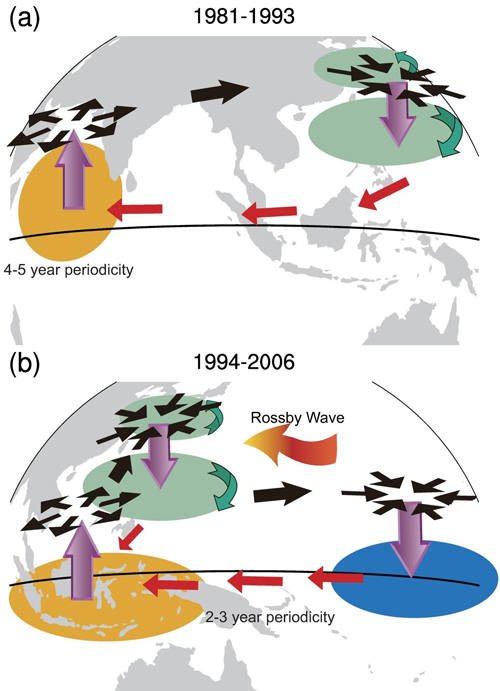Why did interannual periodicity of EA-WNP summer monsoon shift around the early 1990s?
Date:2014-11-13
Around the early 1990s, East Asian – western Northern Pacific summer monsoon (EA-WNPSM) underwent a decadal shift on many aspects. The Pacific-Japan (PJ) Pattern, a prominent signature of the EA-WNPSM, shifted from 4–5 year to 2–3 year periodicity. Previous studies show the tropical SST variability, especially the ENSO, is one of the important drivers of the EA-WNPSM variability. Hence it is critical to understand the decadal shift from SST-forcing perspective. On the other hand, via inter-model comparison across CMIP5 models, it's expected to unfold the limitation on the simulation of monsoon variability, serving to improving the AGCM performance.
CHEN Xiaolong and ZHOU Tianjun from the Institute of Atmospheric Physics (IAP/CAS) found the tropical western Indian Ocean, with prominent 4–5 year periodicity during 1981–1993, can force the same periodicity of the PJ Pattern by Kelvin-wave mechanism (Fig. 1a). In contrast, during 1994–2006, the effective forcing shifts to the maritime continent and central Pacific with 2–3 year periodicity and impact the PJ pattern through the Walker circulation, local Hadley circulation and Rossby waves (Fig. 1b). For multi-model simulations, better the reproduction of above mechanisms, higher the skill in interannual variability in corresponding periods. This decadal shift is a mirror of the change of ENSO variability, corresponding to the increased frequency of Central-Pacific-type El Ni?o events after the 1990s. The anomalous SSTs and circulations in the Indo-Pacific are dominated by the ENSO decaying signal before 1993 but by the ENSO developing signal after 1993, suggesting a weakening of the Indian Ocean "capacitor effect”. In addition, better reproduction of climatological precipitation in the tropical Indian Ocean and central Pacific can significantly improve the response of the EA-WNPSM to the ENSO decaying signal.
The finding is recently published online in Journal of Geophysical Research: Atmospheres.
Reference:
Chen, Xiaolong, Tianjun Zhou*, 2014: Relative role of tropical SST forcing in the 1990s periodicity change of the Pacific-Japan pattern interannual variability, Journal of Geophysical Research - Atmospheres, DOI: 10.1002/2014JD022064, in press.
http://onlinelibrary.wiley.com/doi/10.1002/2014JD022064/pdf

Fig. 1 Schematics of different sources of SST forcing on the PJ pattern, related to the periodicity shift around the early 1990s. (a) Before 1993, warming phase of the western IO and convective heating predominantly affects the PJ pattern by low-level Kelvin wave and high-level divergence/convergence, reflecting dominance of the ENSO decaying signal (b) After 1993, dipole SSTAs in the MC and CP predominantly affect the PJ pattern through combined way: the local Hadley circulation, Walker circulation and Rossby wave, reflecting dominance of the ENSO developing signal. Green shadings represent the wave-like PJ pattern propagating northward. Orange (blue) shading represents warm (cold) SSTAs. Purple arrows represent vertical motion. Black arrows represent high-level divergent wind. Red arrows represent the low-level wind.
Why did interannual periodicity of EA-WNP summer monsoon shift around the early 1990s?
